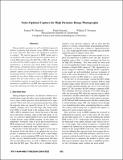Noise-optimal capture for high dynamic range photography
Author(s)
Hasinoff, Samuel W.; Durand, Fredo; Freeman, William T.
DownloadDurand-Noise-optimal capture.pdf (1.264Mb)
PUBLISHER_POLICY
Publisher Policy
Article is made available in accordance with the publisher's policy and may be subject to US copyright law. Please refer to the publisher's site for terms of use.
Terms of use
Metadata
Show full item recordAbstract
Taking multiple exposures is a well-established approach both for capturing high dynamic range (HDR) scenes and for noise reduction. But what is the optimal set of photos to capture? The typical approach to HDR capture uses a set of photos with geometrically-spaced exposure times, at a fixed ISO setting (typically ISO 100 or 200). By contrast, we show that the capture sequence with optimal worst-case performance, in general, uses much higher and variable ISO settings, and spends longer capturing the dark parts of the scene. Based on a detailed model of noise, we show that optimal capture can be formulated as a mixed integer programming problem. Compared to typical HDR capture, our method lets us achieve higher worst-case SNR in the same capture time (for some cameras, up to 19 dB improvement in the darkest regions), or much faster capture for the same minimum acceptable level of SNR. Our experiments demonstrate this advantage for both real and synthetic scenes.
Date issued
2010-08Department
Massachusetts Institute of Technology. Computer Science and Artificial Intelligence Laboratory; Massachusetts Institute of Technology. Department of Electrical Engineering and Computer ScienceJournal
2010 IEEE Conference on Computer Vision and Pattern Recognition
Publisher
Institute of Electrical and Electronics Engineers (IEEE)
Citation
Hasinoff, Samuel W., Fredo Durand, and William T. Freeman. “Noise-optimal Capture for High Dynamic Range Photography.” IEEE, 2010. 553–560. © Copyright 2010 IEEE
Version: Final published version
ISBN
978-1-4244-6984-0
ISSN
1063-6919